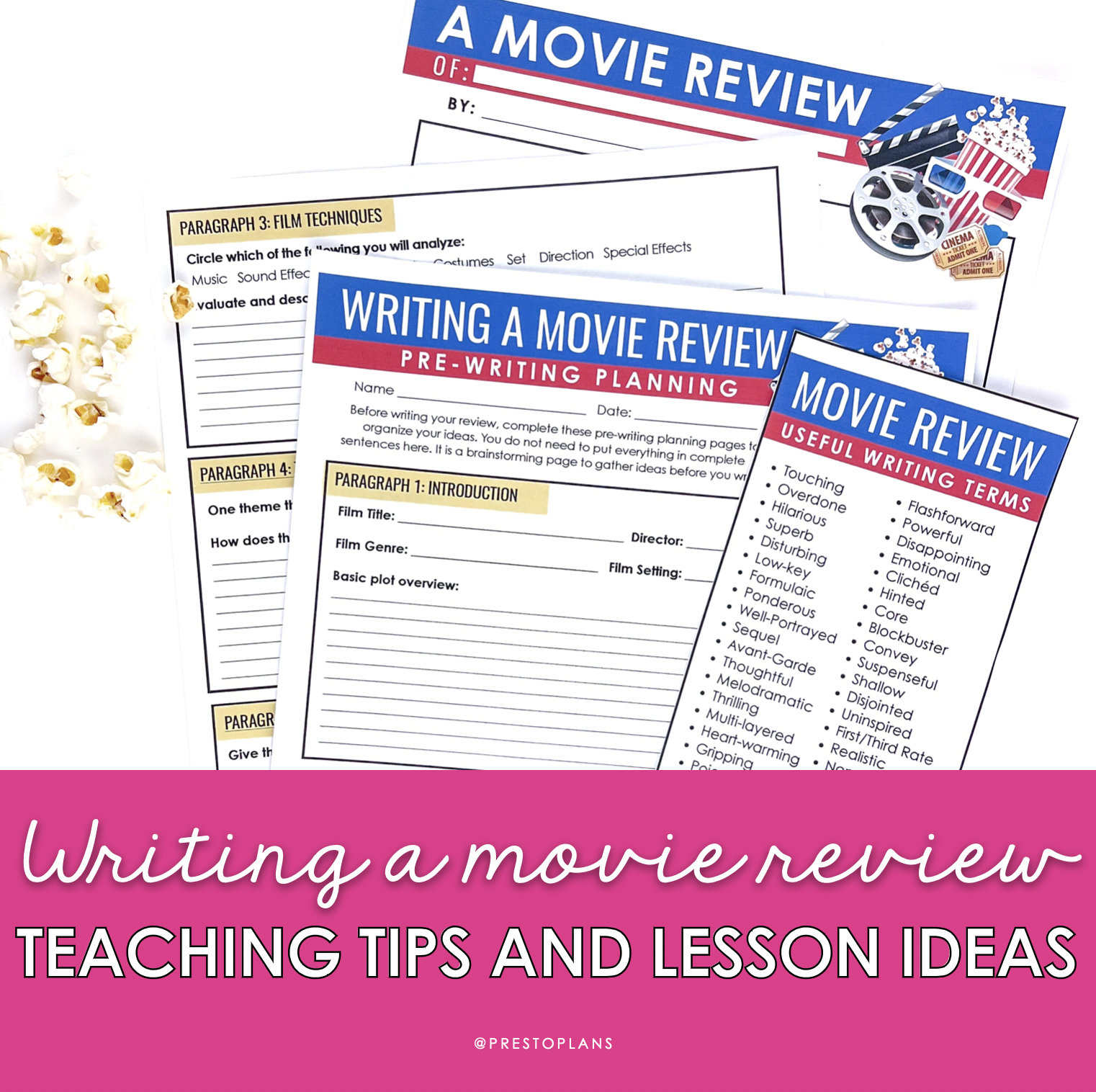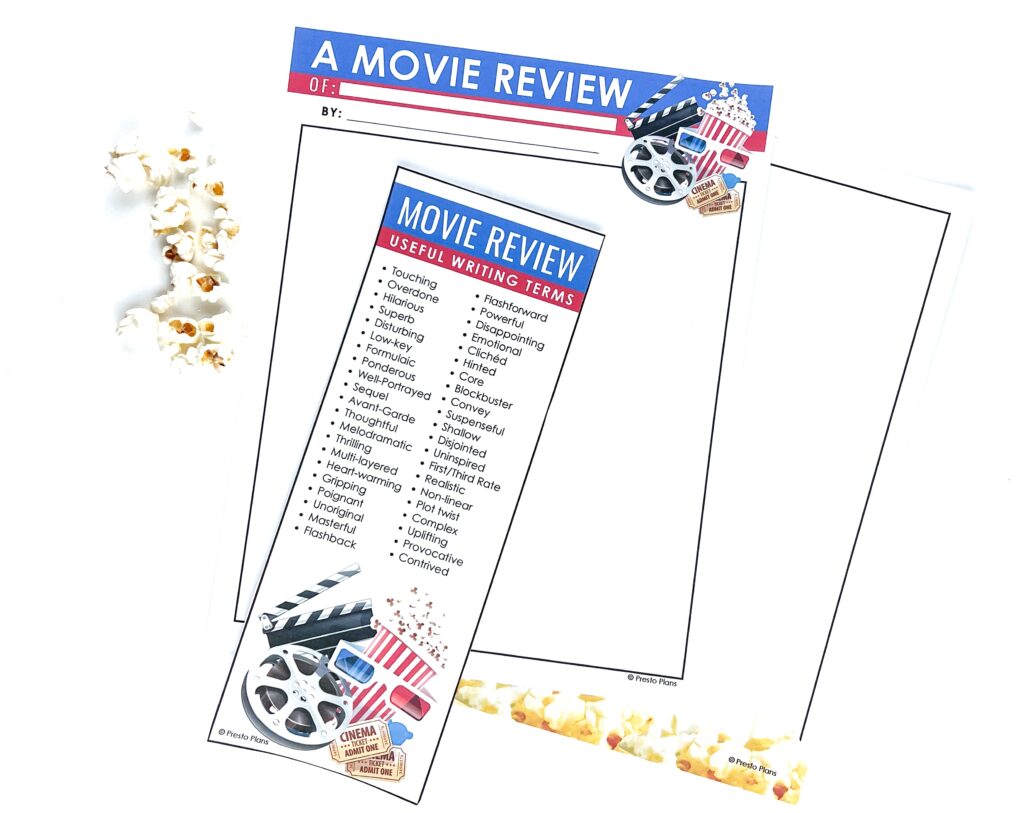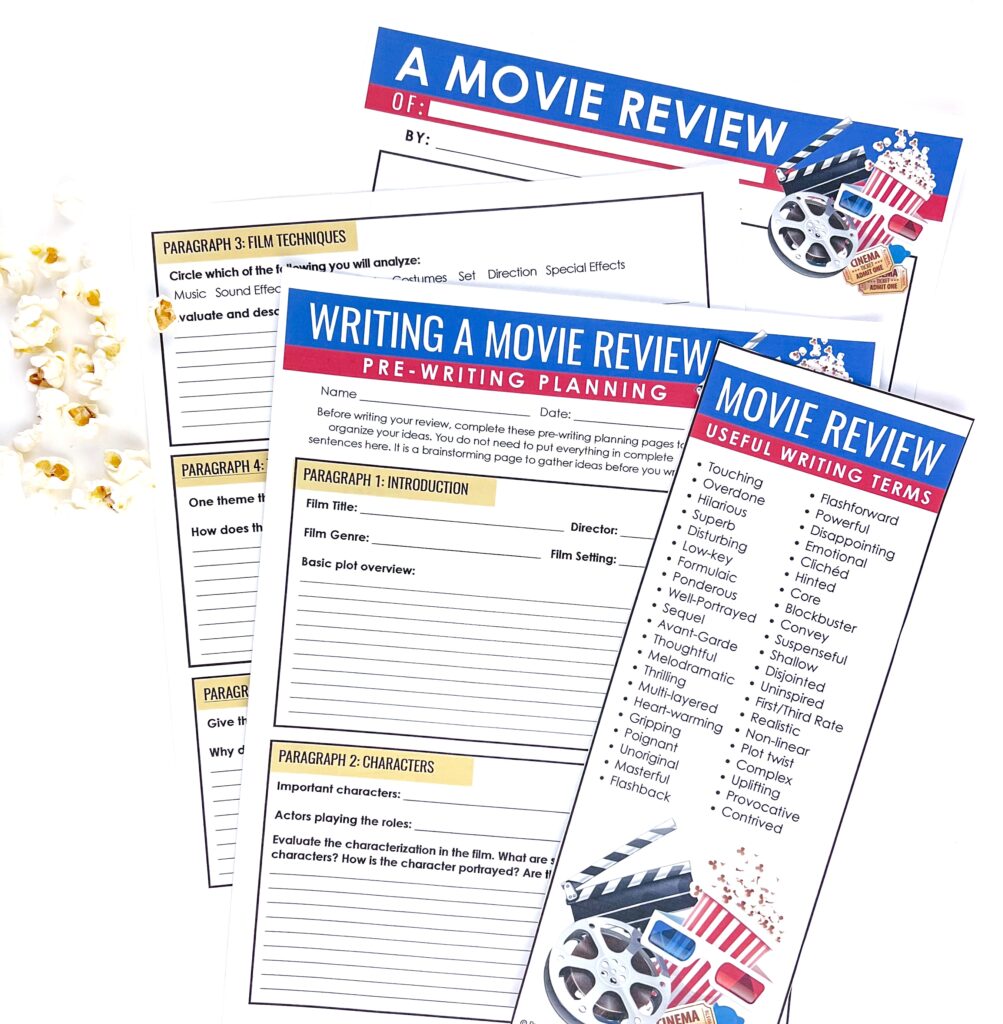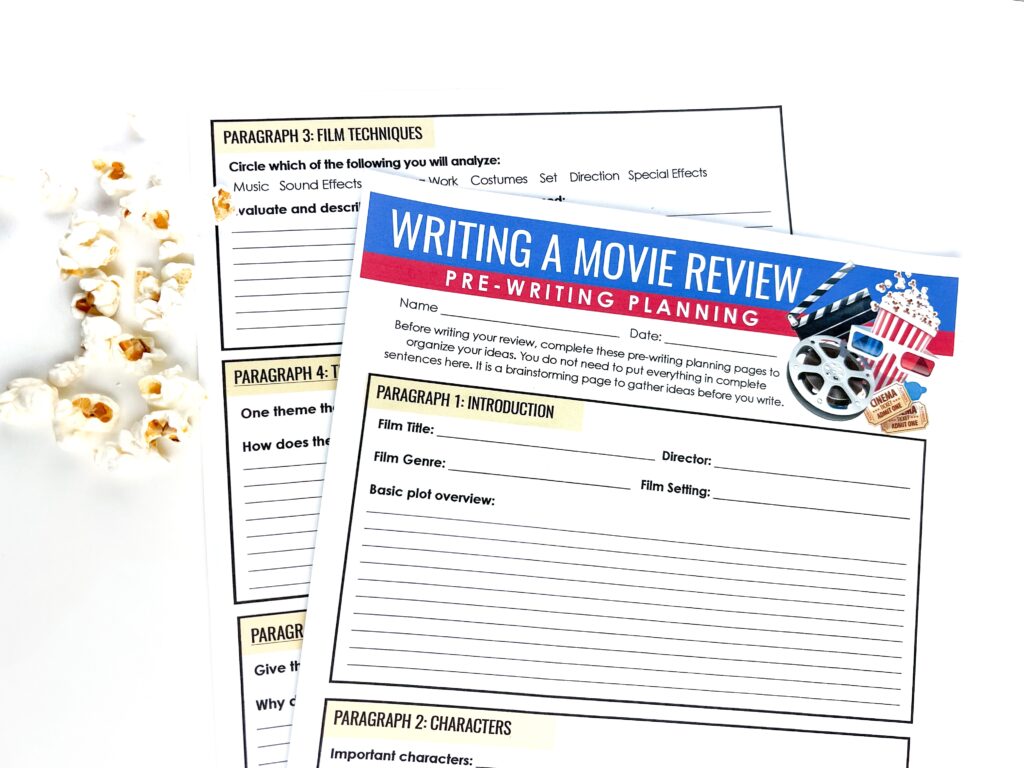PRESTO PLANS
Sent straight to your inbox
CLICK HERE TO ACCESS
Sign up to receive 10 ready-to-use ELA resources your students will love!
10 FREE ELA RESOURCES

Writing a Movie Review: Teaching Tips and Lesson Ideas
To me, there’s nothing more enjoyable as a middle school teacher than blending films into English language arts classes. I’m a real movie lover, and I find that a good film-based activity is the perfect way to engage students in work on essential ELA skills in the last few weeks of school.
Thanks to Netflix, Disney+, and other streaming services, our students have more access to films than people at any other time in history! But I’ve noticed that even with so much exposure to movies, students need quite a lot of guidance to view films critically and with intention.
This is why I find an end-of-year film review project to be so useful in the ELA classroom. Most students are natural movie reviewers already. They always come in on Monday mornings buzzing about the movies they saw over the weekend!
With this in mind, I like to tap into their natural instincts to share what they love, and help them learn the step-by-step organizational skills for writing a film review in the process. Here’s how this looks in the classroom:
1. Show Students Film Review Examples
To begin, I like to lead a brief whole-class discussion where we chat about the difference between getting a recommendation from a friend and reading a professional movie review. During this discussion, I point out that there are some specific things that a movie reviewer considers, including cinematography, actors, lighting, and sound.
Once students have the basic idea, I like to show them several examples of film reviews in different formats. If your school receives a newspaper subscription, you could collect and save film reviews to share with your class. Or, you may prefer a more modern approach and search online! Written film reviews tend to follow a similar structure and provide students with a good understanding of what they need to include.
Because most students also enjoy video content, we spend time looking at YouTube reviews as well. I might be dating myself, but I like to show old clips of Siskel and Ebert, the famous “two thumbs up” reviewers from the ‘80s and ‘90s! What I especially enjoy about their style is that they don’t always agree, but their reviews are still effective and engaging.
2. Know Your Audience
As we wrap up this lesson, I ask students to consider the audience of each review. For example, is the review aimed at children, adults, or even a teen magazine? The target audience affects not only tone and style, but also impacts the focus of the review. For example, a teen magazine review might focus on the famous actors of the film. By contrast, a special effects magazine might provide insight into a particular element of the filmmaking process.
3. Teach How to Watch the Film
The next step is to teach students how to watch a film with purpose, rather than simply for pleasure! In an ideal situation, I recommend watching a film twice. The first time is to get an overall understanding of the plot, and then to consider the choices the director and actors made in creating the film.
In the classroom, I like to pause the film frequently and let my students jot down notes. While they are watching, I remind them to consider each scene with an observant eye. I ask:
- What does the director choose to show (or not show)?
- How do the actors convey emotion, depth, and intention through their movements, as well as their words?
4. Provide Common Vocabulary
As part of a film study, it’s important for students to be able to speak the “language” of movie making. After viewing the movie, I like to take some time to outline some key terms to help students write their reviews.
Words like blockbuster, avant-garde, disjointed, or uninspired can help elevate movie reviews in ELA from “friendly recommendations” to “review quality.” I find a printable list of useful writing terms is especially helpful. This is especially true if you want to avoid the “It was a good movie,” trap!
5. Provide An Organizational Framework
When it comes to actually writing the review, I like to be quite specific in my instructions, breaking down the review into specific paragraphs.
For example, introductory paragraphs should start by engaging the reader with a strong opinion, thought-provoking statement, or even a quote to act as a “hook.” I like to remind students that the purpose of this paragraph is also to share some basic information about the film. This should include title, director, genre, and setting, as well as a brief plot overview. No spoilers, please!
Next, I have students plot out their paragraph about the main characters of the movie. I like to begin this process by having them reflect on the portrayal of the characters, and whether the actors are well-suited for their roles. As they evaluate the performances, middle school ELA students can support their opinions using evidence and examples from the film.
Because film techniques can vary so much from movie to movie, I like to give quite a lot of freedom in the next paragraph. I ask students to consider the following film techniques and choose one to focus on in detail:
- Camera work
- Music
- Sound effects
- Costumes
- Set design
After they have evaluated film techniques, it’s time for students to flex their ELA muscles and reflect on the overall theme of the movie. In their fourth paragraph, I ask them to consider how the director uses filming techniques, set design, characters, conflict, or other elements to express or develop this theme. I like to guide this paragraph by asking questions like:
- Has the theme been developed effectively?
- Does it have an impact on the viewer, a specific community, or the world?
Finally, it’s time to wrap up the review! In this final paragraph, students need to give the film a rating in whatever “system” they choose. Popular choices in my classroom include thumbs up, stars, or even popcorn kernels on a scale of one to five! As they justify their rating and provide their personal opinions, I also encourage the class to consider what type of person would enjoy the movie.
6. Give Prompting Questions
In my experience, prompting questions help students focus on key things to include in their ELA movie review. I like to remind my students that graphic organizers are a tool for working through their ideas. They don’t need to be filled out in complete sentences, but they provide a useful framework for structuring their review.
7. Make time For Peer Feedback & Editing
While students always resist the peer feedback and editing stage of the writing process, it really makes a difference in their overall quality of work.
Before they finalize their review, I have students work with a peer for a closer look at the grammatical and structural elements of their movie review. One way to do this is to follow the “three stars and a wish” format. In this activity, each student has to identify three positive things about the writing and one “wish” – an area of improvement.
Alternatively, if you have an established peer editing process in your classroom, this is a great opportunity to use it!
8. Provide Options for Presentation
Now for the fun part – the presentation of the movie review! I believe that students do their best work when they can express choice and voice in their finished product.
Movie reviews can be shared in a lot of different ways (in the ELA classroom and in real life!). First, I have students select whether they want to share their completed review as a newspaper article, blog post, podcast, pre-recorded video, or even a live presentation in class.
If you’re tight on time, one trick I love is to put students in small groups (I find four works well) and present their reviews to each other. This alternative to whole-class presentations frees me up to circulate among the different groups. You’d be surprised at how much you can see and hear while doing this! At the end of each presentation, I like to have students grade each other using a common rubric. The presenters can self-assess their work as well!
There you have it! I hope you have a blast bringing a movie review assignment into your middle school ELA classroom. Three cheers to the end of the year!
Looking to integrate more videos into your ELA classroom? Check out my suggestions for 7 Ways to Bring Videos Into Secondary ELA.
Wrapping up your year? My 9 Creative Ideas for Student Awards celebrate every student in your class!
Search the blog for what you are teaching
GIVEAWAYS
sent straight to your inbox!





share this post